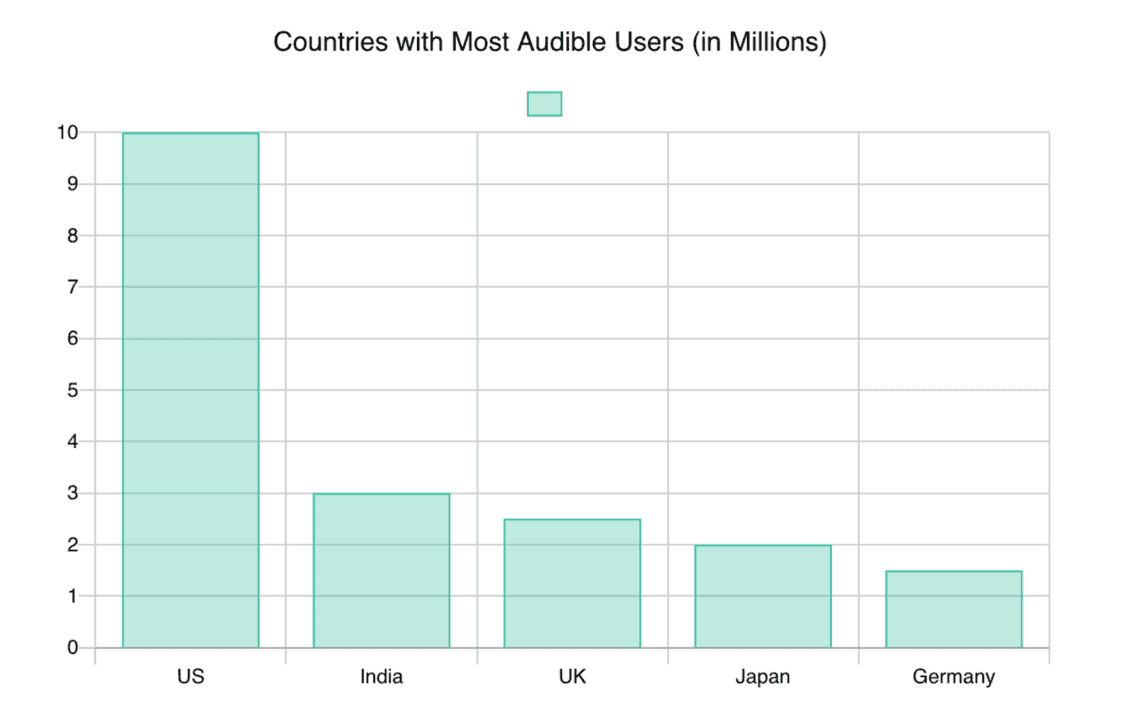Since its launch in 1995, Audible, an Amazon company, has emerged as the leading provider of spoken-word entertainment and audiobooks.
As of 2020, Audible Plus, the paid membership plan offered by Audible, boasted around 300 million monthly users monthly.
Let’s delve into some Audible statistics.
- As of May 2023, over 27.3 Million users visited audible websites.
- In terms of gender distribution among Audible users, 54.44% are male and 45.56% are female.
- When it comes to demographics of Audible users, the platform is most popular among the 25-34 age group, with the next largest user base falling in the 18-24 category, and the 35-44 demographic coming in third.
- Amazon’s Audible commands an impressive 63.4% market share in the U.S. audiobook publishing category as of 2022.
- Audible’s sales accounted for approximately $1.01 billion of the total revenue, showcasing its significant contribution to the industry.
- Audible’s revenue makes up 4.2% of Amazon’s book publishing revenue, solidifying its importance within the Amazon ecosystem.
- The Audible platform churns out an impressive 10,000 titles every year, ensuring a vast and diverse selection for audiobook enthusiasts.
- Audible’s market share has witnessed a remarkable growth of 54.63% since 2018.
- In 2018, Audible accounted for $385.81 million in U.S. audiobook sales, claiming 41% of the market share that year.
- In a 2021 survey, 49% of experts preferred Audible as their audiobook provider, indicating its strong reputation among industry professionals.
Table of Contents
Top 5 countries with the most Audible users

Audible Users Age
| Age group | Audible.com visitors |
|---|---|
| 18-24 years | 20.49% |
| 25-34 years | 27.24% |
| 35-44 years | 18.53% |
| 45-54 years | 14.34% |
| 55-64 years | 11.5% |
| 65+ years | 7.9% |
The Cost of Publishing on Audible
For authors considering publishing an audiobook on Audible, it’s essential to understand the associated costs. Producing a high-quality audiobook requires the services of a skilled narrator, which comes at a price. Here’s a breakdown of the expenses authors can expect:
- Narrator Fees: Authors should budget around $200 per completed hour of the audiobook for the narrator’s services[^1^].
- Average Audiobook Length: The average audiobook is around 10 hours long, meaning authors should allocate at least $2,000 to cover the narrator’s expenses[^1^].
To recoup these costs, authors have two options: choosing an exclusive deal with Audible or opting for a non-exclusive agreement. Let’s explore the break-even points for each scenario:
- Exclusive Deal: Authors who select the exclusive deal must sell a minimum of 250 copies of their audiobook, priced at an average of $20, to cover the narrator’s production costs[^1^].
- Non-Exclusive Deal: For authors who don’t enter into an exclusive agreement, the break-even point is after selling at least 400 copies of their audiobook at the same average retail price[^1^].
These cost breakdowns provide authors with valuable insights into the financial considerations involved in audiobook publishing on Audible.
Controversies Surrounding Audible Royalties
While Audible’s dominance in the audiobook industry is unquestionable, controversies surrounding the royalties paid to authors and narrators have cast a shadow over the platform. Independent researchers claim that the actual royalties paid by Audible are significantly lower than advertised, potentially impacting the earnings of those who publish through the platform[^2^].
According to the claims made by Audiblegate, authors who sign exclusive deals with Audible can expect royalties of 21%, rather than the advertised 40%[^2^]. Similarly, authors who opt for non-exclusive deals may receive royalties of 13%, instead of the promised 25%[^2^]. If authors choose to share royalties with narrators, the percentages are even lower, with 10% for exclusive deals and 7% for non-exclusive deals[^2^].
These discrepancies, if accurate, significantly affect the break-even point for authors. Under the revised royalty rates, an author who signs an exclusive deal would need to sell a minimum of 477 copies of their 10-hour audiobook to cover production costs, while those who opt for a non-exclusive deal would need to sell at least 770 copies[^2^].
It is crucial for authors to consider these potential discrepancies and weigh them against the benefits of publishing on Audible.
Related Post;
References
